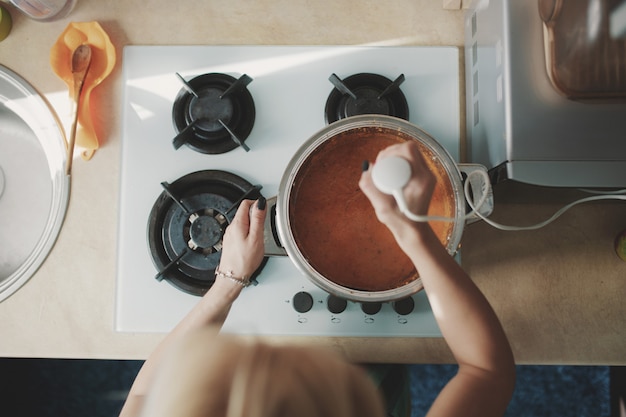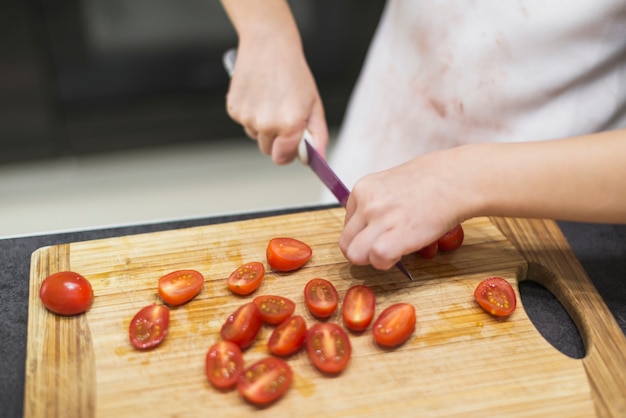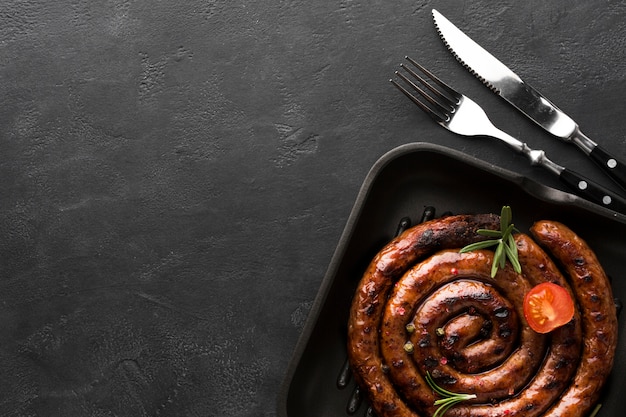Ah, sausages. They're practically a national treasure in Britain, aren't they? A staple in every home, perfect for a quick midweek meal, a hearty weekend brunch, or a show-stopping Sunday roast. But let's be honest, we've all had those moments where the tantalising aroma of sizzling sausages is quickly replaced by disappointment as we encounter burnt, dry, or undercooked sausages. It's a common culinary struggle, my friend. But fear not, because I'm going to share my secrets for cooking perfect sausages on the stovetop, ensuring they're golden brown, juicy, and bursting with flavour every single time.
Through years of experimentation and a few sausage-related mishaps (we all have them, right?), I've learned a thing or two about what makes a truly delicious sausage. From the importance of letting them breathe to the perfect pan temperature, I'm going to unveil the tips and tricks I've accumulated over the years. Prepare to be amazed, because these simple steps will transform your sausage-making game.
(Part 1) Choosing Your Sausages

The Sausage Saga: Quality Matters
Let's get this out of the way – the quality of your sausage is the cornerstone of a truly delicious dish. Forget those supermarket specials crammed with fillers and questionable ingredients. It's time to treat yourself to some good-quality sausages, the kind that sing with flavour. Seek out a butcher’s sausage, those handcrafted beauties made with real meat and minimal additives. If you’re feeling adventurous, why not try your hand at making your own? It's surprisingly satisfying.
When buying, keep an eye out for sausages with a high meat content and a decent fat ratio. That fat is what gives them that incredible juiciness and depth of flavour, so don't be afraid of a bit of fat! You'll notice the difference the moment you sink your teeth into them, trust me.
Variety is the Spice of Sausage Life
Don't limit yourself to the same old sausages! There's a whole world of flavours and textures to explore. Think beyond the usual cheese and onion (although, those have their place for a cheeky treat). Embrace the adventure of Cumberland sausages with their signature coarse grind, the fiery kick of spicy chorizo, or the delicate herb-infused italian sausages.
And, for all my vegetarian and vegan friends out there, don't think you're missing out! There are some fantastic plant-based sausages available, made from ingredients like lentils, mushrooms, and even Quorn. Some are so convincingly meaty, they'll have you questioning your assumptions.
(Part 2) Preparing the Sausages

Let Them Breathe, Baby, Breathe!
Now, here's a crucial step that many people overlook, but it's truly transformative: let those sausages breathe! Take them out of the refrigerator and let them come to room temperature. This might take about 30 minutes, but it's worth the wait. Why? Because allowing the fat to render evenly results in juicier, more flavourful sausages.
The Prickly Truth: Puncturing for Perfection
Here's another tip that will save you from burnt, crispy sausages. Before you even think about putting those beauties in the pan, use a fork or a sharp knife to prick a few holes in each sausage. It might seem counterintuitive, but trust me, it's a game-changer. The holes allow steam to escape while cooking, preventing the casing from bursting and creating those dreaded crispy bits. They also help to cook the sausages more evenly, ensuring that every bite is delicious.
Casing Chronicles: A Tale of Two Types
You've probably noticed that sausages come in two main casing types: natural and artificial. natural casings, crafted from animal intestines, tend to give the sausages a slightly better bite. However, they can be a bit more prone to bursting. artificial casings, made from cellulose or other materials, are generally more robust and less likely to split open. Ultimately, it comes down to personal preference.
(Part 3) Cooking the Sausages

Choosing the Right Tools
With your sausages prepped and ready to go, it's time to choose the right pan. A heavy-bottomed pan or skillet is your best bet, as it will distribute heat evenly and prevent hot spots. Those uneven cooking zones can lead to unevenly cooked sausages, and nobody wants that!
Now, for the oil. Opt for a neutral oil with a high smoke point, such as sunflower or vegetable oil. Olive oil adds a lovely flavour, but its lower smoke point makes it prone to burning at high heat.
Setting the Stage for Sizzling Perfection
Start by heating your pan over medium-high heat. You want that pan hot enough to sear the sausages quickly and create that irresistible golden-brown crust. Don't overcrowd the pan, as this will lower the temperature and lead to uneven cooking.
Searing the Sausage: A Moment of Truth
Once your pan is sizzling hot, carefully place the sausages in the pan, making sure they have plenty of space to breathe. Let them sear for a few minutes on each side without moving them, allowing a beautiful crust to develop. It's tempting to fiddle with them, but resist the urge!
Patience is a Virtue (Especially with Sausages)
Once your sausages are nicely browned on all sides, reduce the heat to medium and continue cooking them, turning them occasionally to ensure even cooking. This is where patience comes in. Don't rush the process! The sausages need time to cook through and reach a safe internal temperature. A good rule of thumb is to cook them for about 10-12 minutes for smaller sausages and 15-20 minutes for larger sausages.
(Part 4) Checking for Doneness
The Old-School Method
You can check if your sausages are cooked through by gently pressing on them with a fork. If the juices run clear, they're cooked. If they're still pink, give them a few more minutes.
The Digital Thermometer: A Scientific Approach
For a more accurate temperature check, use a digital thermometer inserted into the thickest part of the sausage. The internal temperature should reach 160°F (71°C). This ensures they're thoroughly cooked and safe to eat.
(Part 5) Serving Your Sausages
Rest and Relaxation: A Culinary Pause
Once your sausages are cooked to perfection, remove them from the pan and place them on a plate or wire rack to rest for a few minutes. This allows the juices to redistribute, making them even more juicy and flavorful.
Accompaniment Extravaganza
Now for the fun part! There are endless possibilities when it comes to serving your sausages. Here are a few of my personal favourites, but feel free to get creative:
- Classic Mash and Onion Gravy: A timeless combination that never fails to satisfy. You can add a touch of mustard to the gravy for a bit of extra zing.
- Roasted Vegetables: Roasted vegetables, such as carrots, potatoes, and onions, add a burst of colour and flavour to your plate.
- Green Salad: For a lighter option, serve your sausages with a fresh green salad.
- Baked Beans: A quintessential British sausage accompaniment, baked beans are always a crowd-pleaser.
- Apple Sauce: A sweet and tart apple sauce provides a lovely contrast to the richness of the sausages.
- Savoury Breadcrumbs: For a crunchy topping, scatter some toasted breadcrumbs over your sausages.
(Part 6) cooking tips and Tricks
Now, let's delve into some of those little tips and tricks that can elevate your sausage-cooking game.
Avoid Overcrowding the Pan
This is crucial! If you overcrowd the pan, the temperature will drop, and your sausages will steam rather than brown. Cook them in batches if necessary, ensuring each sausage gets its fair share of the pan's heat.
Use a Spatula, Not a Fork
Resist the urge to use a fork to turn your sausages. It's tempting, but it can puncture the casing and release those precious juices. Use a spatula to gently flip them over, preserving their integrity and those tasty flavours.
Don't Drain the Fat (Hear Me Out!)
You might be tempted to drain the fat from the pan, but I recommend leaving it in. The rendered fat will add flavour to the sausages as they cook. It's a secret ingredient for that extra oomph.
Save the Pan Drippings
Once your sausages are cooked, don't throw away those pan drippings! They're a treasure trove of flavour. Use them to make a delicious gravy or sauce, transforming them into a culinary masterpiece.
Experiment with Flavour
Don't be afraid to get creative with your sausage flavours. Try adding different herbs, spices, or even a splash of wine to the pan during cooking. A hint of rosemary, a sprinkle of paprika, or a splash of white wine can add a whole new dimension to your sausages.
(Part 7) Variations and Ideas
Now that you've mastered the art of cooking perfect sausages, let's explore some delicious variations and ideas.
Sausage and Bean Casserole
Combine cooked sausages, beans, and your favourite vegetables in a casserole dish. Cover with a cheesy topping and bake until bubbly and golden brown. This hearty dish is perfect for a cozy winter evening.
sausage rolls
Wrap cooked sausages in puff pastry and bake until golden brown. Serve with a dipping sauce of your choice, such as a tangy mustard sauce or a creamy cheese sauce.
Sausage and onion pizza
Top a pizza base with cooked sausages, onions, and your favourite pizza toppings. Bake until the cheese is melted and bubbly. This is a fun and easy way to use up leftover sausages.
Sausage and Apple Crumble
Combine cooked sausages, apples, and a crumble topping. Bake until the crumble is golden brown and the apples are soft. This sweet and savoury dish is a delightful twist on the classic apple crumble.
(Part 8) FAQs
1. Can I cook sausages in a microwave?
While you can technically cook sausages in a microwave, it's not the best method. The sausages will likely end up rubbery and dry. Stick to the stovetop or oven for the best results.
2. How long can I store sausages in the fridge?
Uncooked sausages can be stored in the fridge for up to 2-3 days. Make sure they are wrapped well to prevent cross-contamination.
3. Can I freeze sausages?
Yes, you can freeze sausages. They can be frozen for up to 2-3 months. To freeze them, wrap them well in cling film or freezer bags. Thaw them in the fridge overnight before cooking.
4. What if my sausages burst while cooking?
Don't worry if a few sausages burst while cooking. It's not the end of the world! Just try to avoid pricking them too much in the future.
5. Can I reheat cooked sausages?
Yes, you can reheat cooked sausages. The best way to reheat them is to heat them in a pan over medium heat with a little oil. You can also reheat them in the oven or microwave.
Everyone is watching

Corn on the Cob: The Ultimate Guide to Perfectly Cooked Ears
Healthy MealsAh, corn on the cob. Just the name evokes images of sunny days, barbecues, and that sweet, juicy flavour that ...

Scallops: The Ultimate Guide to Perfect Cooking
Healthy MealsAh, scallops. Those delicate, sweet, and utterly delicious morsels of the sea. They hold a special place in my...

Spaghetti Squash: The Ultimate Guide to Cooking and Serving
Healthy MealsRemember that time you saw spaghetti squash at the supermarket, looking all bumpy and strange, and thought, "W...

Salmon Cooking Times: Perfect Guide for Every Recipe
Healthy MealsLet me tell you, cooking salmon is an art form. It's all about getting that perfect balance: juicy and tender,...

Ham Cooking Time: How Long to Bake, Smoke, or Boil a Delicious Ham
Healthy MealsAh, ham. It's a classic, isn't it? A real crowd-pleaser, especially around holidays. And when done right, it'...
